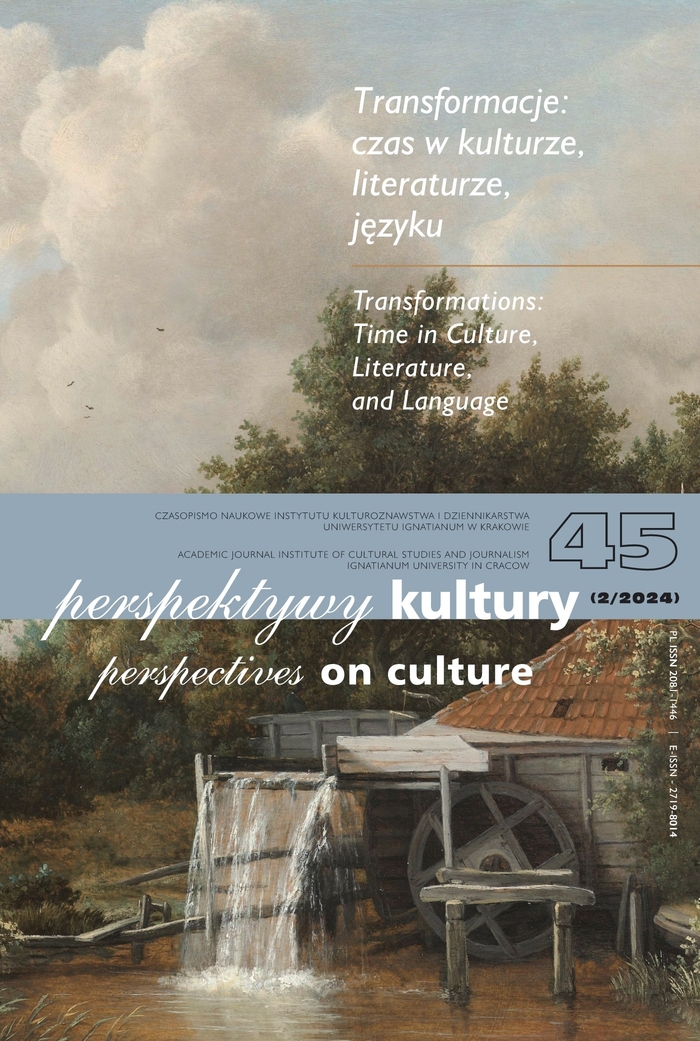Entropiczne transformacje i czas we wczesnych utworach Thomasa Pynchona
Abstrakt
Artykuł bada złożone relacje pomiędzy entropią a czasem w drugiej powieści Thomasa Pynchona 49 Idzie pod młotek, analizując znaczenie i funkcje entropicznych procesów na narracyjne sposoby przedstawiania czasu i doświadczenia czasowego. Artykuł dowodzi, że twórcze wykorzystanie entropii przez Pynchona polega na specyficznym operowaniu tym pojęciem jako odmiennym od stagnacji czy też cyklicznej powtarzalności oraz na zastosowaniu go do zobrazowania nieodwracalnych przemian czasu doświadczanego i „lokalnych temporalności”. Czas w 49 Idzie pod młotek nie tylko płynie w różnym tempie, ale także gęstnieje lub ulega rozproszeniu. Znajduje to odzwierciedlenie w powieści, która ukazuje alternatywne czasowości jako lokalne nisze, usytuowane „bokiem” w stosunku do pierwotnej ramy narracyjnej tekstu. Projektując te alternatywne czasowości, narracja Pynchona odwołuje się do strategii wyobraźni, dekonstrując czas rzeczywistości empirycznej za pomocą inwersji temporalnej i jednoczesności.
Bibliografia
Azarian, B. (2022). The Romance of Reality. Dallas, TX. BenBella Books.
Dalsgaard, I. (2012). Science and Technology. In: I. Dalsgaard, L. Herman, B. McHale (eds.), The Cambridge Companion to Thomas Pynchon. Cambridge, Cambridge University Press, 156-167.
Grant, J. K. (1991). Not Quite so Crazy after all These Years: Pynchon’s Creative Engineer. Pynchon Notes 28-29, 43-53.
Letzler, D. (2015). Crossed-Up Disciplinarity: What Norbert Wiener, Thomas Pynchon, and William Gaddis Got Wrong about Entropy and Literature. Contemporary Literature 56(1), 23-55.
Mendelson, E. (1978). The Sacred, the Profane, and The Crying of Lot 49. 1975. In: E. Mendelson (ed.), Pynchon: A Collection of Critical Essays. Englewood Cliffs, NJ: Prentice-Hall, 112-46.
Misztal, A. (2019) Time and Vision Machines in Thomas Pynchon’s Novels. Frankfurt. Peter Lang.
Misztal, A. (2020). Dream time, modality, and counterfactual imagination in Thomas Pynchon’s” Mason & Dixon”. Polish Journal for American Studies, 37-55.
Pynchon, T.(1984, Oct 28). Is it O.K. to Be a Luddite? The New York Times Book Review, 1, 40-41.
Pynchon, T.(1985a). Entropy. In: T. Pynchon, Slow Learner: Early Stories. 1984. Boston: Back Bay Books, 1985. 79–98.
Pynchon, T. (1985b). Introduction. In: T. Pynchon, Slow Learner: Early Stories. 1984. Boston: Back Bay Books, 1–23.
Pynchon, T. (1986). V. 1963. New York: Perennial.
Pynchon, T. (1995). Gravity's Rainbow. 1973. London: Penguin Books.
Pynchon, T. (1993, June 6). Nearer, My Couch, to Thee. The New York Times Book Review, 3, 57.
Pynchon, T. (1999). The Crying of Lot 49. 1966. New York: HarperCollins.
Pynchon, T. (2009). Inherent Vice. London: Jonathan Cape
Rezaei, H., & Samani, M. A. (2012). The Chaotic World and the Entropic Crisis in Thomas Pynchon’s The Crying of Lot 49. Journal of Foreign Language Teaching and Translation Studies 1, 83-98.
Schuber S.P. (1983). Rereading Pynchon: Negative Entropy and ‘Entropy.’ Pynchon Notes 13 (1983): 47–60.
Smith, M. & Tólólyan, K. (1986). The New Jeremiad: Gravity’s Rainbow. 1981. In: H. Bloom (ed.) Thomas Pynchon, New York: Chelsea House, 139-155.
Tanner, T. (1971). City of Words: American Fiction, 1950–1970. New York: Harper.
Turner, F. (2023). Turns and Turnings: the Dynamics of Logogenesis [unpublished manuscript], The University of Texas, Dallas.
Thoreen, D. (1992). The Economy of Consumption: The Entropy of Leisure in Pynchon’s Vineland. Pynchon Notes 30-31, 53-62.
Wiener, N. (1954). The Human Use of Human Beings: Cybernetics and Society. 1948. Boston: Houghton Mifflin.
Copyright (c) 2024 Perspektywy Kultury

Utwór dostępny jest na licencji Creative Commons Uznanie autorstwa – Bez utworów zależnych 4.0 Międzynarodowe.
Autor, zgłaszając swój artykuł, wyraża zgodę na korzystanie przez Wydawnictwo Uniwersystet Ignatianum z utworu na następujących polach eksploatacji:
- utrwalania utworu w formie papierowej, a także na nośniku cyfrowym lub magnetycznym;
- zwielokrotnienia utworu dowolną techniką, bez ograniczenia ilości wydań i liczby egzemplarzy;
- rozpowszechniania utworu i jego zwielokrotnionych egzemplarzy na jakimkolwiek nośniku, w tym wprowadzenia do obrotu, sprzedaży, użyczenia, najmu;
- wprowadzenia utworu do pamięci komputera;
- rozpowszechniania utworu w sieciach informatycznych, w tym w sieci Internet;
- publicznego wykonania, wystawienia, wyświetlenia, odtworzenia oraz nadawania i reemitowania, a także publicznego udostępniania utworu w taki sposób, aby każdy mógł mieć do niego dostęp w miejscu i czasie przez siebie wybranym.
Wydawca zobowiązuje się szanować osobiste prawa autorskie do utworu.





